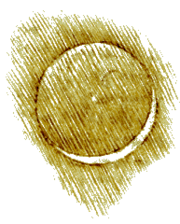Earthshine
|
|

The phenomenon known as Earthshine is reflected Earthlight visible on the Moon's night side. It is also known as the Moon's "ashen glow" or "the old Moon in the new Moon's arms".
Earthshine is most readily observable shortly before and after a new Moon. When the Moon is new as viewed from Earth, the Earth is fully lit up as viewed from the Moon. Sunlight is reflected from the Earth to the night side of the Moon. The night side appears to glow faintly and the entire orb of the Moon is dimly visible.
Leonardo da Vinci explained the phenomenon in the early 1500s when he realized that both Earth and the Moon reflect sunlight. Light is reflected from the Earth to the Moon and back to the Earth as Earthshine.
Earthshine is used to help determine the current albedo of the Earth. The data are used to analyze global weather phenomena. Oceans reflect the least amount of light, roughly 10%. Land reflects anywhere from 10-25% of the Sun's light, and clouds reflect around 50%. So, the half of the Earth where it is daytime determines how bright the Moon's Earthshine appears at any given time.
Studies of Earthshine can be used to show how the Earth's cloud cover varies over time. Preliminary results show a 6.5% dip in cloud cover between 1985 and 1997 and a corresponding increase between 1997 and 2003. This has implications for climate research, especially with regards to global warming. Some clouds have a net warming effect because they trap heat, while others have a net cooling effect because they increase albedo, so the overall effect on global temperature remains unclear. [1] (http://skyandtelescope.com/news/article_1287_1.asp)
See also: André-Louis Danjon, Danjon scale.
External links
- Science@NASA: Earthshine (http://science.msfc.nasa.gov/headlines/y2002/12apr_earthshine.htm)
- NASA Astronomy Picture of the Day (http://antwrp.gsfc.nasa.gov/apod/ap020419.html), 19 April 2002
- 'Earthshine' Linked to Solar Cycle, Climate Change (http://www.space.com/scienceastronomy/planetearth/earth_shine_010417.html), Space.com
- Scientists Watch Dark Side of the Moon to Monitor Earth's Climate (http://www.agu.org/sci_soc/prrl/prrl0113.html), American Geophysical Union

